The ancient cities of Thessaloniki and Athens, with their monuments and museums, along with the “sexy” islands like Mykonos and their white-washed buildings and pristine beaches, are classic stops on tours of Greece for their culture, history and beauty. However, some of Greece’s lesser-known natural wonders, authentic towns and archaeological sites are just as stunning – and have many fewer tourists, allowing for a more intimate experience. Including any of the following nine places in your itinerary will make your trip even more memorable.
Vergina

Vergina, the site of the burials of Macedonian kings, is an hour’s drive north of Thessaloniki. Here you can stroll around unusual mound-shaped tombs (“tumuli”) dating from the 11th-8th centuries B.C. and through a substantial 4th century B.C palace with royal banquet halls, one with a beautiful mosaic floor. However, it is underground where the true marvel awaits.
Constructed in 1993, the Royal Tombs Museum is entered through an unassuming doorway built into one of the mounds. Inside are the exposed interiors of three of the circa 300 B.C. tombs: enclosed and protected in glass, you get an up-close look of the tomb excavations, including their stunning wall paintings. Much of the “bling” – the gold, glass, ivory, marble and wood artifacts from the tombs – is also on display. Of particular note is the tomb of Philip II, Alexander the Great’s father: the Doric temple facade with a marble door, topped with an Ionic frieze, includes a painting of a hunting scene with figures of Philip and Alexander and is one of the only known surviving examples of ancient Greek painting of this kind.
>> Read about day trips from Thessaloniki
[social]
Meteora
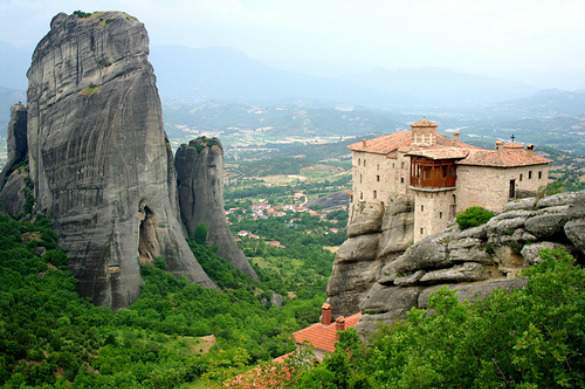
Drive two and one-half hours southwest of Thessaloniki to find Meteora, a UNESCO World Heritage Site that abounds with fantastic peaks created by nature’s erosion of the surrounding rock. The spires appear inaccessible and it is difficult to imagine the resolve of the religious hermits who first climbed up to settle in the caves and fissures. In the 9th century, monks topped the towers with monasteries. Some of the monasteries have been turned into museums; all are worth the climb up steps to visit, but being reasonably fit will make the trek that much more enjoyable.
Even if you are not up to the climb, the view is still remarkable: from first light through to the evening hours, the sun washes the gray rocks with a paint box of colors; at night the towers are spectacularly illuminated by spotlights. Meteora is also treasured by Greeks as the inhabitants helped in keeping alive Greek Orthodox religious traditions and Hellenic culture during the Middle Ages and the Turk occupation of Greece from 1453 to 1829.
Gytheon
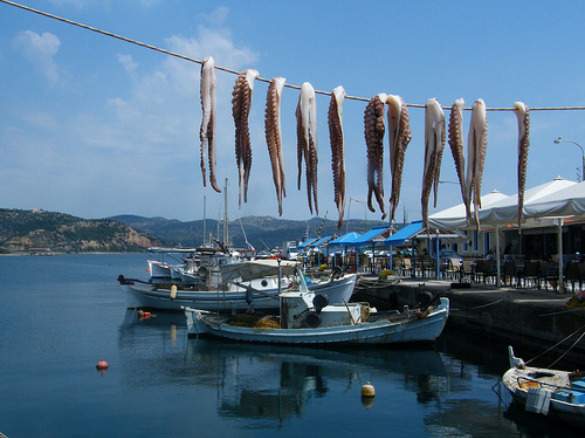
Gytheon is a three hour drive southwest of Athens. This small port town spreads down the side of Mount Koumaros to the sea, and is a great base for day trips in the southern Peloponnese part of the country. It has not yet been discovered by the tour companies, and you will feel like you are in “real” Greece as you wander along the port and through the small streets lined with neo-classical buildings with flower-laden balconies. The beauty of the surrounding area made it a perfect setting for the movie “The Tempest.”
Restaurants and cafes abound – take a break after sightseeing and enjoy typically Greek grilled octopus alongside a glass of “ouzo” at an outside taverna. On the south side of the town is the small, pine covered island of Kranai with its Ethnological Museum, housed in an Ottoman tower, and 25 meter high lighthouse. On the other side of the town you will find an ancient theater from the 1st Century.
>> Learn more about Greek food
Diros Caves

After a 1 ½ hour scenic drive northwest from Gytheon, you will reach the underground waterways of the Diros Caves, which are among the most stunning natural attractions in Greece. Archeological finds include plenty of mammal fossils, including one of the largest discoveries of hippopotamus bones in Europe. Paleolithic and Neolithic artifacts (on display in the adjacent museum) have been found here as well, indicating that the caves were one of the earliest inhabited places in Greece.
The caves are estimated to be about 14 kilometers long, but only about 1,500 meters can be seen on a guided visit. The 30 minute tour is by boat and starts at the edge of an underground lake, where you will don a hard-hat and life preserver. The guide uses poles to maneuver the boat through the caverns and tunnels, which are eerily lit and decked out with breathtaking stalactites and stalagmites. Warning for the seriously claustrophobic: some sections are just wide enough to allow the boat passage, and in some stretches you have to duck your head. The air is about seventy degrees year-round, so a sweater or light jacket is recommended for those who get cold easily.
Mystras

Forty kilometers north of Gytheon lay the ruins of the city of Mystras, another UNESCO World Heritage Site. Overlooking the city of Sparta, Mystras began as a fortress built in 1249, and was expanded by the Venetian and Turk occupiers. The ruins are spread over the side of tree-dotted Mt. Taygetos and consist of a Citadel near the peak and fortified Upper, Middle and Lower Towns cascading further down the mountain.
The site was abandoned in 1832, but is now occupied by a convent of nuns who care for the antiquities. As you walk along its paths, you will wonder at the palaces, walls and gates as well as well-maintained frescos inside the many churches such as Agios Demitrios, where you will also find the Archaeological Museum of Mystras and its Byzantine and Ecclesiastical exhibits.
>> Book a hostel in Sparta
Epidaurus

Epidaurus is one of the most beautiful archaeological sites in all of Greece. The drive is about 2 hours (125 kilometers) southwest from Athens. Here, at the temple of Asclepius, Greeks paid tribute to their God of medicine and healing and asked for remedies for various illnesses. However, the main attraction is the breathtaking 3rd century, 14,000 seat limestone amphitheater.
Even through Roman occupation, Epidaurus retained its circular “orchestra”, and is close to acoustically perfect: from the top seats you may be able to hear someone whispering on the stage down below. In July and August the amphitheater returns to its prior grandeur when the Epidaurus Festival presents ancient Greek classics – including the tragedies of Aeschylus, Sophocles and Euripides – in Modern Greek. For information on performances, visit www.true-athens.com.
Stavros
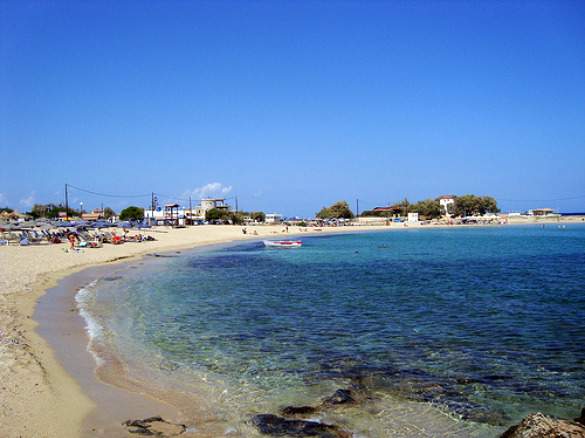
If you are partial to rocky hills, scented with wild herbs and decorated with geraniums, sandwiched between volcanic coastlines and olive groves and vineyards heavy with fruit, you will want to visit Stavros. Located about 30 minutes north of the city of Chania on the northwest side of Crete’s Akrotiri Peninsula, there are a few small and well-manicured “apart-hotels”, but Stavros has yet to be overrun by tourists.
Visit many serene inlet beaches with clear-as-glass turquoise waters where you can rent two lounge chairs and umbrella for about 5 Euro per day – a relative bargain for Europe. This is also the perfect area for long and easy road runs (or walks), where you will see an abundance of bougainvillea, as well as oleander, palm and orange trees. Drop by Christiana’s tavern on Stavros Beach for some fresh grilled fish, Cretan cheese pies and a glass of retsina; owner/chef Maria may let you have your picture taken with the Oscar™ for cinematography won by “Zorba the Greek,” which was filmed here. Many of the locals were extras in the movie, and Walter Lassally, who won the treasured gold statue, has a home nearby.
>> Find hotels in Crete
Gorge of Aradena
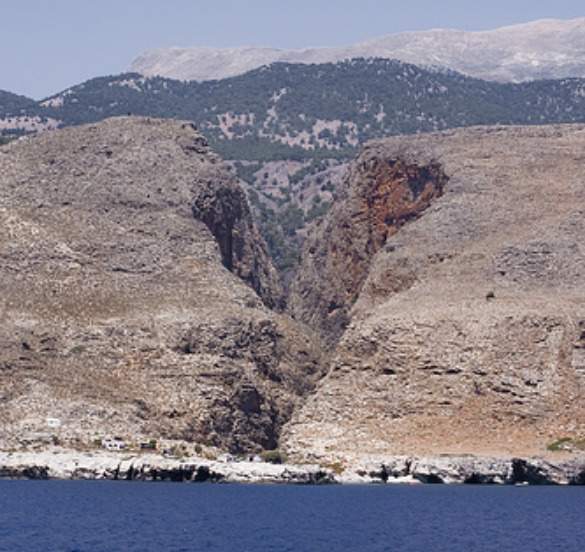
If you have even a bit of experience with nature walks, and little or no vertigo, hiking the Gorge of Aradena is an ideal alternative to the better-known Samaria Gorge and its almost 2,000 daily visitors. Begin your hike at the small beach of Marmara, which is an hour’s walk along the coast from the town of Loutro (about 80 kilometers – 1 ¾ hours – south of Chania on the island of Crete) and then head uphill – it is easier to walk up than down – towards the southern slopes of the White Mountains.
The main section of the trail is just less than 3 hours long, and includes a cliff-side passage which can be traversed via a 10 meter high metal ladder; if you do suffer a fear of heights, take the alternative path with its handrail. Towards the end of the trek, cross the 138-meter high Aradena Bridge for a stunning view of the gorge below.
Kameiros
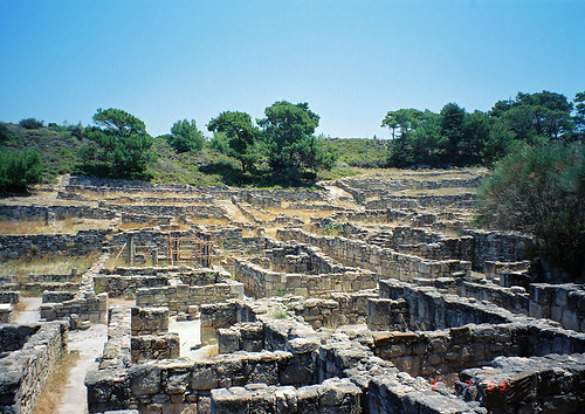
After a 30 kilometer drive west from the city of Rhodes, on the island of Rhodes, including the final stretch up a switchback road on a tranquil, pine-filled mountain, you will arrive at the ancient Minoan ruins at Kameiros. Inhabited since 2000 B.C., Kameiros joined Lindos and Ialyssos in the 5th century B.C. to form the grand city-state of Rhodes. Kameiros, also known as the “Greek Pompeii,” was flattened by an earthquake in 226 B.C. and was ultimately abandoned in 142 A.D. after being destroyed by another. However, the town’s foundations were well-preserved under the debris from the second quake, protecting it from looters.
There are well-preserved temples, bath houses, stone staircases, store rooms, and private dwellings with great views of the Aegean Sea. You will also see the cistern that supplied approximately 400 residents with fresh water, and a highly developed drainage system. Unlike many archaeological sites in Greece, there is a reasonable amount of descriptive signage; as an added plus there are not any attempts at reconstruction.
Greece is hot and dry in the high season (July and August), so plan your outdoor sightseeing– with water bottle, hat and sun block – for first thing in the morning; leave your afternoons for relaxing or swimming. In mountainous areas, such as Meteora and the Aradena Gorge, keep a sharp eye out for falling rocks, especially if it has recently rained or if there are goats or sheep above you. Lodging can be less expensive other times of the year, but call ahead if you plan to visit off-season as many places are closed at that time.
Visit BootsnAll’s WhyGo Greece site for everything you need to plan your trip to Greece, including cheap flights to Greece, the best Greece hotels, and how to book ferries in Greece. And learn more about travel in Greece below:
Photos by: damiandude, bogdan, tortipede, Moncivais, gichristof, Rosino , alxaris78, marcopoulos, Pet_r